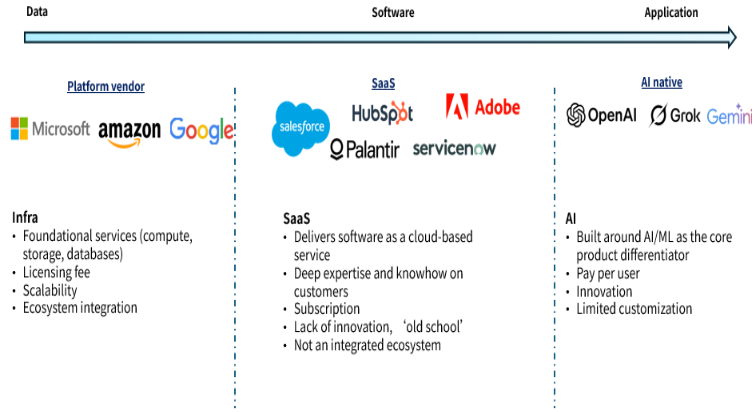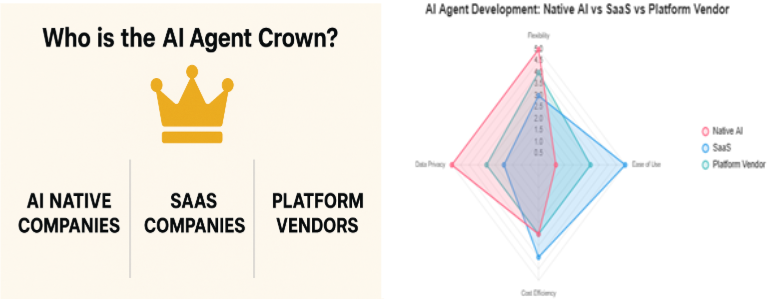AI native companies, SaaS or platform vendors - The Crown Goes to...?

In this episode, we dive deeper further into the subject of AI agent from our previous article Poseidon Partner - Foresights - Invisible Head of Future Human Being to share our views as to who are likely to be on the podium of this race.
Imagine a world where your day begins with a gentle nudge from an invisible companion, an AI agent that not only brews your coffee to perfection but also curates your morning playlist, schedules your meetings, and whispers market insights before you step into the office. This isn’t a distant fantasy—it’s the pulsating reality of AI agents, digital entities poised to weave intelligence into every facet of our lives. But who will lead this vibrant future? Will it be AI-native companies, born from the crucible of machine learning innovation? SaaS giants, with their scalable, user-friendly platforms? Or platform vendors, the tech titans controlling the ecosystems where AI thrives? Let’s dive into this kaleidoscope of possibility, exploring what AI agents are, their potential, and the contenders—complete with vivid examples like OpenAI, Salesforce, Amazon, and Microsoft—vying to shape their destiny.

What Are AI Agents?
AI agents are not your grandmother’s chatbots or static scripts. They are dynamic, autonomous entities powered by artificial intelligence, capable of perceiving their environment, reasoning, and acting to achieve goals with a finesse that feels almost human. Picture a digital sidekick that doesn’t just follow orders but anticipates your needs, learns from your habits, and adapts in real-time. These agents blend machine learning (ML), natural language processing (NLP), and sometimes emotional intelligence to interact seamlessly with humans and systems. Key concepts that define AI agents include:
• Autonomy: They operate independently, making decisions based on data and objectives without constant human oversight
• Learning: Through reinforcement learning or supervised training, they evolve, refining their actions with every interaction
• Context Awareness: They grasp the nuances of their environment—your calendar, your mood, or even global market trends
• Interoperability: They integrate with APIs, databases, and IoT devices, orchestrating complex tasks across platforms.
Think of an AI agent as a maestro conducting a digital symphony, harmonizing disparate systems to create a melody tailored to you. From personal assistants like Siri to enterprise agents optimizing supply chains, they’re evolving from tools to indispensable partners.
The Landscape of the Future
The future of AI agents is a vibrant tapestry, each thread weaving intelligence into daily life. In homes, they could manage energy use, adjusting lights and thermostats based on your family’s rhythms. In businesses, they might predict inventory needs or craft hyper-personalized marketing campaigns. In healthcare, imagine agents monitoring patients’ vitals, alerting doctors to anomalies before they escalate. By 2030, the AI agent market could be worth hundreds of billions, fuelled by generative AI, edge computing, and 5G. But who will weave this tapestry? Let’s meet the contenders—AI-native companies, SaaS providers, and platform vendors—who will win the AI agent future?
The Contenders for the AI Agent Crown
1. AI-Native Companies
The Visionaries of Intelligence AI-native companies are the alchemists of the digital age, built from the ground up to harness AI’s potential. Firms like OpenAI and Anthropic are unburdened by legacy systems, focusing solely on pushing the boundaries of intelligence. Their agents are not just tools—they’re sparks of innovation, designed to think, reason, and create.
Why They Could Win: AI-native companies are agile, attracting top talent—machine learning PhDs, data scientists, and visionaries who see AI as the next internet. Their agents, built on cutting-edge models, approach human-like reasoning. Their lack of baggage allows them to experiment boldly, creating agents that redefine industries.
Challenges: Scaling to billions of users is a hurdle. These firms excel in niche domains—scientific research, creative writing—but lack the infrastructure for mass adoption. Training large models is also costly, often requiring partnerships with bigger players.
Example 1: OpenAI’s ChatGPT Agent as a Taskmaster
Imagine a busy professional in 2025, juggling deadlines and meetings. With the recent launch of OpenAI’s ChatGPT Agent on July 17, 2025, this agent transforms the ChatGPT platform into an action-oriented ally. Accessible via the "agent mode" to Pro, Plus, and Team plan subscribers, it navigates calendars, generates editable presentations, and even runs code—all with a seamless interface. Picture it schedules your day, drafting a slideshow for a client pitch, and debugging a script in real-time, all while adapting to your workflow. This is OpenAI’s bold step into autonomous agents, leveraging its GPT heritage to blend conversational prowess with practical execution. However, its reliance on subscription tiers and ongoing real-world testing may limit its immediate scalability.
2. SaaS Giants
The Scalers of Simplicity SaaS companies like Salesforce and HubSpot have mastered delivering scalable, user-friendly solutions to businesses worldwide. They’re now embedding AI agents into their platforms, transforming CRMs and IT systems into proactive partners that anticipate needs and streamline workflows.
Why They Could Win: SaaS giants have the infrastructure to deploy AI agents at scale, serving millions from startups to Fortune 500s. Their agents are practical, solving real-world problems like automating customer support or optimizing sales pipelines. Integration is their forte—their platforms plug seamlessly into existing workflows, making AI accessible to non-technical users.
Challenges: SaaS firms often lack the deep AI expertise of native companies, relying on third-party models. This can limit innovation. They also risk commoditization—when every CRM has an AI agent, differentiation is tough. Their enterprise focus may also leave consumer markets untapped.
Example 2: Salesforce’s Agentforce as a one-stop office assistant
Picture a sales manager in 2032, juggling leads across continents. Her Salesforce dashboard, powered by Agentforce, is no mere CRM—it’s a strategic ally. Agentforce, now a fully autonomous agent, analyzes customer data, predicts high-value leads, and drafts personalized emails in her voice. It joins video calls, taking notes and suggesting real-time responses based on the client’s tone and history. When a deal stalls, Agentforce negotiates terms, cross-referencing past contracts and market trends, all within Salesforce’s secure cloud. Agentforce showcases how SaaS giants embed AI into workflows. Salesforce’s massive user base and integration capabilities make its agents accessible to businesses of all sizes. However, reliance on external AI models could cap innovation, and its enterprise focus may not captivate individual consumers.
3. Platform Vendors
The Ecosystem Emperors Platform vendors like Amazon and Microsoft are the titans of tech, controlling the ecosystems where billions live. AWS, Azure, and devices like Echo or Surface are the digital highways for AI agents. These companies have the infrastructure, data, and reach to make agents ubiquitous.
Why They Could Win: Platform vendors have unmatched scale. Amazon’s Alexa and Microsoft’s Copilot are already household names, integrated into devices, cloud services, and operating systems. Their ecosystems—AWS for computing, Azure for enterprise—enable seamless agent deployment. Their data troves fuel hyper-personalized agents.
Challenges: Trust is a hurdle. Privacy scandals and monopolistic practices make users wary. Their agents, designed to lock users into ecosystems, may struggle with interoperability. Innovation can also lag—stability trumps experimentation.
Example 3: Amazon’s Alexa as a Lifestyle Orchestrator
Imagine 2035: you wake to Alexa’s soothing voice, now an AI agent far beyond a smart speaker. Integrated via AWS, Alexa manages your smart home, adjusting lights and brewing coffee based on your sleep patterns, tracked via your Fitbit. It schedules your day, syncing with your calendar and suggesting a lunch spot based on your cravings, learned from years of data. When you’re stuck in traffic, Alexa negotiates a delivery slot for your groceries, all while streaming a podcast tailored to your mood. This is Amazon’s vision: an agent that’s the pulse of your life, powered by its vast ecosystem. Alexa’s strength is its reach—Amazon’s devices and cloud dominate consumer and enterprise spaces. Yet, privacy concerns and ecosystem lock-in could alienate users seeking flexibility.
Example 4: Microsoft’s Copilot as an Enterprise Maestro
Now, picture a corporate executive in 2032, navigating a global merger. Microsoft’s Copilot, embedded in Azure and Teams, is her digital consigliere. It analyzes financials, drafts contracts, and predicts market reactions, all while coordinating with her team across time zones. During a Teams call, Copilot transcribes, translates, and suggests negotiation tactics based on real-time sentiment analysis. It seven integrates with Salesforce, pulling data to ensure alignment. This is Microsoft’s bet: an agent that powers enterprises, leveraging Azure’s scale and Office’s ubiquity. Copilot’s enterprise focus and Azure’s infrastructure make it a powerhouse. But its ecosystem-centric approach may limit interoperability, and consumer trust remains a challenge.

The Battle for Supremacy
The future of AI agents is a three-way dance. AI-native companies like OpenAI spark innovation, crafting agents like ChatGPT Agent that push intelligence forward. SaaS giants like Salesforce scale practicality, embedding agents like Agentforce into workflows. Platform vendors like Amazon and Microsoft dominate through ecosystems, making agents like Alexa and Copilot ubiquitous. By 2035, the winner may be a collaboration—OpenAI’s brains powering Salesforce’s delivery, deployed via AWS or Azure. This synergy could create a world where agents anticipate our needs with uncanny precision.

Selective stock complications
Salesforce (CRM)
Role: SaaS leader integrating AI agents like Agentforce into enterprise workflows.
Implication: Salesforce’s focus on Agentforce positions it for significant growth in the $129 billion enterprise AI market. Agentforce’s ability to reduce sales cycles by 31% and handle 85% of customer inquiries autonomously (with only 2% escalation) could drive substantial revenue growth. Currently contributing ~5% ($900 million annual recurring revenue, also stands for ARR) to Salesforce’s $9.5 billion Q4 FY25 subscription revenue, Agentforce is projected to reach $1.7 billion in revenue by FY30, potentially accounting for 20% of total revenue within five years (up from 5% now). Strategic acquisitions like Informatica ($8 billion, closing Q2 FY26) and partnerships with Google (Gemini AI) and Convergence.ai bolster Agentforce’s capabilities, enhancing Salesforce’s competitive edge against Microsoft and Google.
Key Catalyst: Widespread adoption of Agentforce in industries like finance, healthcare, or retail, or strategic AI partnerships, could boost stock performance. Monitor enterprise AI adoption metrics in earnings reports.
Amazon (AMZN)
Role: Platform vendor scaling AI agents via AWS and Alexa’s consumer reach.
Implication: Amazon’s leadership in AI agent deployment is driven by its dual strengths in AWS, which commands a 31% share of the $80 billion global cloud market, and Alexa, powering over 500 million devices worldwide. AWS’s AI offerings, including Bedrock and SageMaker, processed 2.3 trillion transactions in Q2 2025, generating $26.3 billion in revenue (14% YoY growth) and enabling collaborative AI solutions for enterprises. Alexa, integrated into 40% of U.S. smart homes, strengthens Amazon’s consumer AI ecosystem with 1.2 billion monthly interactions, enhancing user engagement through personalized recommendations and voice-driven automation. This versatility positions Amazon for robust long-term stock growth, with market projecting a 12% CAGR for AWS and a $3 trillion market cap by 2030. Strategic partnerships, such as with Anthropic for Claude integration and potential collaborations with Salesforce’s Agentforce, could further enhance Amazon’s AI capabilities. It is expected that Agentforce could contribute 25% revenue in the next five years vs. 40% now.
Key Catalyst: Enhancements to Alexa’s AI capabilities or AWS partnerships with AI firms could act as significant stock drivers. Track AI-related cloud revenue in quarterly reports.
Microsoft (MSFT)
Role: Platform vendor with Azure and Copilot driving enterprise AI agent adoption.
Implication: Microsoft’s Azure platform and Copilot’s integration into productivity tools, combined with its existing OpenAI partnership, position it as a frontrunner in AI agent ecosystems. Azure AI’s 60,000 enterprise customers, including 85% of Fortune 100 companies, leverage its 1,700+ AI models, with a 45% increase in AI workload deployments YoY. Copilot, embedded in Teams, Outlook, Excel, and GitHub, has driven a 29% productivity boost, with 75% of Microsoft 365 E5 subscribers (approximately 90 million users) adopting it, contributing $1.8 billion in ARR in Q3 FY25 (120% YoY growth). By 2035, Azure’s AI ecosystem is expected to drive a 16% CAGR, with Copilot’s enterprise adoption projected to reach 90% of Microsoft 365 users, adding $5 billion in ARR. It is expected that Agentforce could contribute 30% revenue in the next five years vs. 40% now.
Key Catalyst: Deeper integration with OpenAI or expanded Copilot functionality in enterprise settings could drive stock gains. Monitor Azure’s AI-related revenue growth.
A Vivid Vision of 2035
Step into 2035, Your AI agent, a fusion of OpenAI’s ChatGPT Agent and Amazon’s Alexa, greets you through smart earbuds, adjusting your home’s lighting to mimic a sunrise. At work, Salesforce’s Agentforce preps your day, flagging a critical meeting and drafting a proposal, while Microsoft’s Copilot coordinates with global teams. By evening, your agent books a restaurant, curates a playlist, and learns from your smile. This is the trajectory—agents as invisible allies, weaving intelligence into life.
Conclusion
In the mid-term, these three players—AI-native companies, SaaS giants, and platform vendors—are likely to coexist, each contributing unique expertise and capabilities to advance AI agent adoption. SaaS giants, with their deep expertise and tailored solutions in vertical industries such as finance, healthcare, and retail, may excel in these domains by seamlessly integrating AI agents into industry-specific workflows to address unique business needs. However, in the long term, platform vendors such as Amazon and Microsoft are poised to dominate, thanks to their robust ecosystem buildup, deep understanding of customer and business needs, and substantial capital reserves. Their ecosystems, integrating cloud services, devices, and data resources, enable large-scale agent deployment and highly personalized experiences. Combined with market insights and financial strength, platform vendors are well-positioned to lead sustained AI innovation and infrastructure development. Meanwhile, the expertise and agility of AI-native companies and SaaS providers will foster collaboration, shaping a future where AI agents not only assist but anticipate needs and enhance efficiency. This future is approaching rapidly, brimming with potential.
